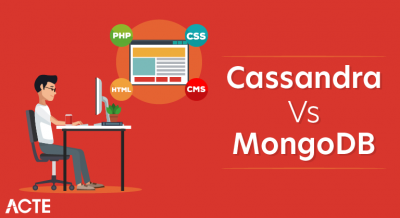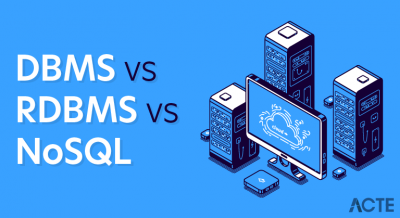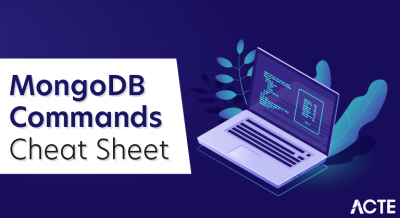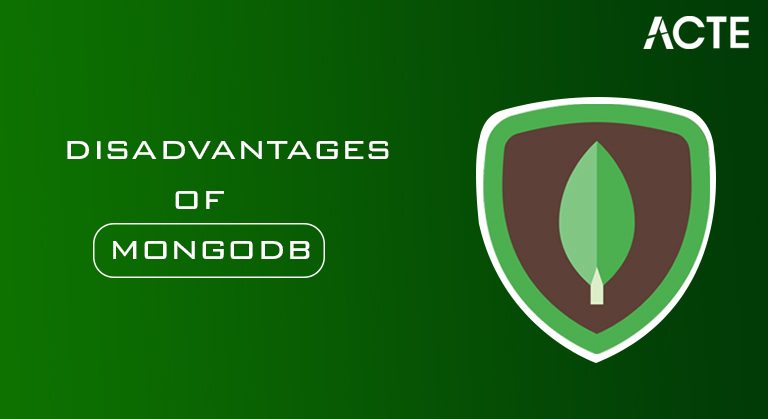
In the class of document-oriented databases, MongoDB is a well-known NoSQL (Not Only SQL) database management system. It saves data in adaptable, JSON-like documents known as BSONs (Binary JSON), which are designed to manage unstructured or semi-structured data.
- Introduction to MongoDB Vs MySQL
- Detailed comparison of data integrity, ACID traits, and transaction control between MongoDB vs MySQL
- Functionalities of MongoDB
- Functionalities of MYSQL
- Comparing the security features and controls in MongoDB with MySQL for data protection
- Benefits of Using MangoDB and MySQL
- When to Use MongoDB vs MySQL
- MongoDB vs MySQL User-Friendliness
- MongoDB vs MySQL Performance
- MongoDB vs MySQL Flexibility
- MongoDB vs MySQL Security
- Conclusion
Introduction to MongoDB Vs MySQL
MangoDB
MongoDB is a NoSQL document-oriented database that uses adaptable BSON documents for data storage. Its dynamic architecture allows each document to have unique fields without a predetermined schema, making it suitable for modern online applications, mobile app backends, real-time analytics, and IoT applications with adaptable data needs.
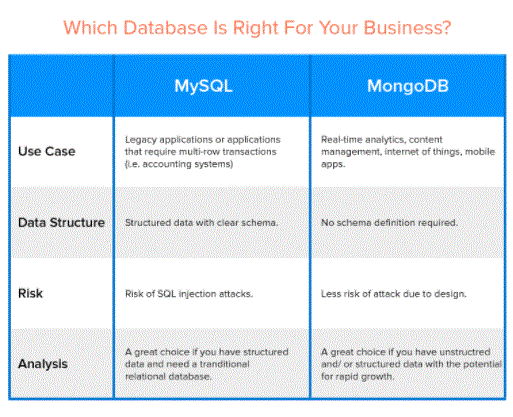
- Organising data with the well-liked relational database management system and storing structured data is called MySQL. It is open-source. Databases are managed by MySQL using Structured Query Language (SQL), which enables users to create, change, and query data in a tabular fashion.
- MySQL maintains data consistency and transaction support by adhering to the ACID (Atomicity, Consistency, Isolation, Durability) characteristics.
- MySQL is a widely used RDBMS with a large user base and extensive features, excelling in structured data, data integrity, and complex SQL queries.
MySQL
- MongoDB ensures data integrity through unique indexes, compound indexes, and validation rules on document fields.
- Due to the trade-offs between scalability and performance and some ACID features, MongoDB is not an entirely ACID-compliant database.
- At the level of a single document, it ensures atomicity, consistency, and isolation, but it does not permit complete multi-document transactions.
- A single write operation on a document in MongoDB is certain to be atomic because it enables atomic operations at the document level.
- MongoDB ensures consistency in single documents, but inconsistent across multiple documents.
- MongoDB provides isolation for read and write operations within a single document, not for transactions involving multiple documents.
- By writing data to disc, MongoDB ensures data durability, preventing data loss in the case of a system failure.
- MongoDB 4.0 introduces multi-document transactions, combining multiple operations into atomic units for successful or failed operations.
- MongoDB’s write concerns enable users to specify data persistence level, allowing for explicit acknowledgment level of write operations.
- MongoDB provides snapshot isolation for read operations, ensuring consistent data snapshots for transactions.
- For read operations inside of a transaction, MongoDB provides the isolation levels Read Uncommitted and Snapshot.
- MongoDB uses OCC for simultaneous data access by multiple readers and writers.
- MongoDB provides strong consistency guarantees for single documents, but for multi-document transactions, it depends on isolation level.
- When it comes to transactions, MongoDB can manage partial failures, enabling some operations to still be successful even when others fail.
- Assuring that changes to a document are atomic and consistent, MongoDB offers atomic updates at the document level.
- Within a single replica set or sharded cluster, MongoDB supports transactions that span several collections.
Detailed comparison of data integrity, ACID traits, and transaction control between MongoDB vs MySQL
Here is a thorough analysis of MongoDB’s data integrity, ACID traits, and transaction control.
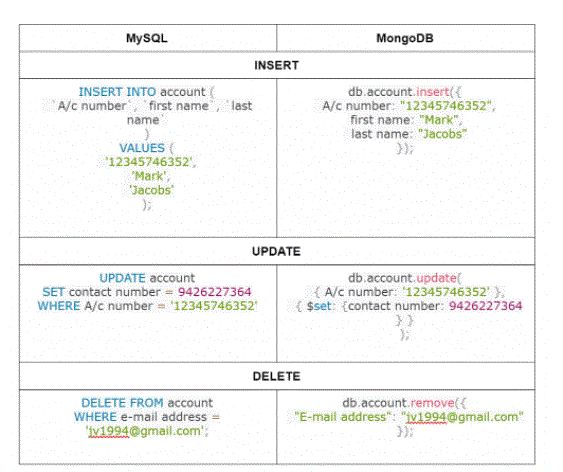
- Primary keys, foreign keys, unique keys, and check constraints are just a few of the constraints that MySQL uses to maintain data integrity.
- Fully supporting all ACID qualities, MySQL is an RDBMS that complies with ACID standards.
- All activities within a transaction are either fully performed or rolled back if an error occurs because MySQL provides atomicity for transactions.
- By enforcing data rules through constraints, MySQL ensures consistency and keeps the database in a usable state.
- MySQL offers transaction isolation, guaranteeing that each transaction is separate from the others and that their processes do not conflict.
MySQL:
Here is a thorough analysis of the data integrity, ACID traits, and transaction control of MySQL:
- The documents in a collection may have different fields since MongoDB lacks a predefined schema.
- Strong query support and indexing are provided by MongoDB to improve data retrieval.
- MongoDB has excellent scalability and performance by distributing data over numerous servers.
- Replica sets are provided by MongoDB to support fault tolerance and data redundancy.
- A strong aggregation architecture for data processing and analytics is offered by MongoDB.
Functionalities of MongoDB:
The following are some of MongoDB’s key functionalities:
- In tables with rows and columns, MySQL stores data.
- Using limitations like primary keys and foreign keys, MySQL upholds data integrity.
- Provides diverse index types for improved query performance.
- provides transactions that are ACID-compliant for data consistency.
- Creates and manages user accounts with specific privileges.
- Provides fault tolerance and high availability data replication.
- enables automatic reactions to events in the database.
- enables the creation and use of server-side processes.
- provides virtual tables to make data access and security easier.
- gives text-based data the ability to be fully searched.
- allows for the backup and restoration of data for disaster recovery.
- enables fine-tuning of server settings for performance.
Functionalities of MySQL:
The following are some of MySQL’s key functionalities:
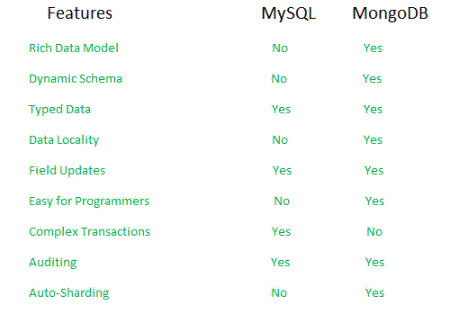
- Users must first log in to MongoDB using their credentials before they can access the database. The database must be accessed using credentials even though MySQL supports user authentication.
- RBAC is used by MongoDB, giving administrators the ability to give users particular roles and permissions. RBAC is implemented in MySQL, enabling administrators to provide users roles and rights.
- MongoDB uses AES encryption techniques to protect data stored on disc, while MySQL uses similar methods for securing disc-based data.
- MongoDB uses AES encryption for data protection at rest, while MySQL uses disc-based encryption methods.
- MongoDB supports SSL/TLS encryption for secure data transfer, MySQL protects it.
- MongoDB offers robust auditing and logging features for monitoring user activity and database operations, unlike MySQL’s limited features.
- MongoDB and MySQL enable administrators to enforce password restrictions and enforce effective user password rules.
- MongoDB supports third-party authentication systems like LDAP and Kerberos, while MySQL offers various authentication plugins.
- MongoDB administrators can designate trusted IP addresses for database access, while MySQL allows IP whitelisting for regulated access.
- MongoDB provides vulnerability scanning for identifying security flaws, while MySQL offers security study and evaluation instruments.
- MongoDB and MySQL maintain data security by controlling user sessions and access credentials.
- MongoDB supports multiple authentication methods, while MySQL integrates pluggable and unique schemes.
- MongoDB and MySQL maintain data security by controlling user sessions, access credentials, and user sessions.
- MongoDB’s native firewall features enable access control rules, while MySQL offers secure communication options.
- The vibrant community surrounding MongoDB enables prompt security updates and improvements to counter new dangers. While the vibrant MySQL community guarantees timely security upgrades and ongoing development.
Comparing the security features and controls in MongoDB with MySQL for data protection
Comparing the security features and controls of MongoDB with MySQL:
- MongoDB is a good option for applications that require real-time data processing and quick response times due to its speedy read and write performance and indexing functionalities.
- MongoDB’s expressive query language enables complex queries, including filtering, sorting, and aggregation, for data management.
- MongoDB is suitable for agile development and rapid iterations in a data-driven environment since it supports ad hoc queries without requiring the schema to be defined in advance.
Benefits of Using MangoDB
Some of the primary benefits of using MongoDB are as follows:
- Being open-source, MySQL is accessible for free usage, modification, and distribution.
- MySQL is cross-platform and works with many different operating systems.
- MySQL has strong security capabilities.
- MySQL offers integration with popular web technologies and is suitable for web applications.
Benefits of Using MySQL
Some of the primary benefits of using MySQL are as follows:
- The main differences between these two database systems are significant. Choosing which one to use is really a question of approach rather than a purely technical decision.
- MySQL is a mature relational database system, providing a familiar database environment for experienced IT professionals.
- MongoDB is a well-established, non-relational database system that offers superior flexibility and horizontal scalability, but at the cost of some of the security features of relational databases, such as referential integrity.
When to Use MongoDB vs MySQL:
- MongoDB is an attractive option for developers. Its data storage philosophy is simple and immediately understandable to anyone with programming experience.
- MongoDB stores data in collections without any applicable schema. This flexible approach to storing data makes it particularly suitable for developers who may not be database experts yet want to use databases to support the development of their applications.
- Compared to MySQL, this flexibility is a significant advantage: to get the best out of a relational database, you must first understand the principles of normalisation, referential integrity, and relational database design.
- With the ability to store documents of various schemas, including unstructured data sets, MongoDB provides a flexible developer interface for teams that are building applications that do not require all the security features provided by relational systems. . A common example of such an application is a web application that does not depend on a structured schema; It can easily provide unstructured, semi-structured, or structured data from a single MongoDB collection.
- MySQL is a common choice for users who have extensive experience using traditional SQL scripting, designing solutions for relational databases, or who are modifying or updating existing applications that are already integrated with a relational system. work. Relational databases may also be a better choice for applications that require very complex but rigid data structures and database schemas involving large numbers of tables.
- A common example of such a system might be a banking application that requires very strong referential integrity and transactional guarantees to maintain accurate point-in-time integrity of the data.
- However, it is important to clarify that MongoDB also supports the ACID properties of transactions (atomicity, consistency, isolation, and durability). This enables greater flexibility in building a transactional data model that can scale horizontally in a distributed environment and has no impact on the performance of multi-document transactions.
MongoDB vs MySQL User-Friendliness:
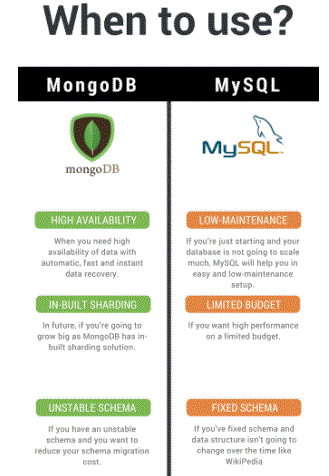
- It is very difficult to assess the performance of two completely different database systems, as both the management systems perform the task of data storage and retrieval in completely different ways. While it is possible to directly compare two SQL databases with a set of standard SQL benchmarks, achieving the same in non-relational and relational databases is more difficult and subjective.
- For example: MySQL is optimised for high performance joins on multiple tables that are indexed appropriately. In MongoDB, joins are supported with the $lookup operation, but they are less needed due to the way MongoDB documents are used; They follow a hierarchical data model and keep most of the data in one document, therefore eliminating the need to join multiple documents.
- MongoDB is also optimised for write performance, and features a specific insertMany() API for fast data insertion, prioritising speed over transaction safety that requires inserting MySQL data row by row. Looking at some of the high-level query behaviours of the two systems, we can see that MySQL is faster at selecting a large number of records, while MongoDB is significantly faster at inserting or updating a large number of records.
MongoDB vs MySQL Performance:
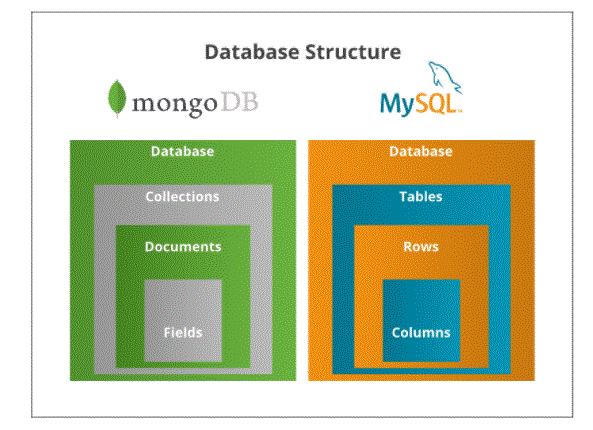
- This one is easy, and a hands-on win for MongoDB. The schematic design of MongoDB documents makes it extremely easy to build and scale applications over time without the need to run complex and expensive schema migration processes as you would with a relational database.
- With MongoDB, there are more dynamic options for updating a collection’s schema, such as creating new fields based on the aggregation pipeline or updating nested array fields. This advantage is especially important as databases grow in size. In contrast, larger MySQL databases are slower to migrate schemas and stored procedures that may depend on the updated schema. MongoDB’s flexible design makes this much less of a concern.
- It’s worth noting that both databases have a lot in common. Both are free to get started, are easy to install on both Linux and Windows, and both have extensive programming language support for popular languages such as Java, Node.js, and Python.
- In addition, MongoDB offers MongoDB Atlas, a managed cloud solution, that is forever free to use for exploratory purposes, while for the MySQL managed cloud version, you will need an agreement with one of the major public cloud providers. Have to keep an account and come inside them. Free tier conditions for non-payment.
MongoDB vs MySQL Flexibility:
- MongoDB leverages the popular role-based access control model with a flexible set of permissions. Users are assigned a role, and that role grants them specific permissions on data sets and database operations. All communications are encrypted with TLS, and it is possible to write encrypted documents to the MongoDB data collection using a master key that is never available to MongoDB, achieving encryption of the data at rest.
- MySQL supports the same encryption features as MongoDB; Its authentication model is also similar. Users can be given roles, but privileges can also be granted, allowing them to perform particular database operations and against particular data sets.
MongoDB vs MySQL Security:
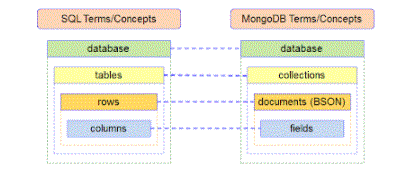
- MongoDB represents data in the form of JSON documents whereas MySQL represents data in tables and rows.
- In MongoDB, you don’t need to define schema, whereas in MySQL you need to define your own tables and columns
- MongoDB does not support JOIN but MySQL supports JOIN operations.
- MongoDB uses JavaScript as the query language while MySQL uses Structured Query Language (SQL).
- MongoDB is an ideal choice if you have unstructured and/or structured data with potential for rapid growth, whereas MYSQL is a great option if you have structured data and need a traditional relational database.
- If most of your services are cloud based then MongoDB is best suited for you but if data security is your priority then MYSQL is the best option for you.
- In this article, we have talked about the main differences between MongoDB and MySQL, which are a schemaless non-relational database system and a relational database system respectively. We have explained when it is better to use one over the other. We’ve discussed the scalability, performance, and user-friendliness for each system. Lastly, we have also explained the flexibility and security features for both the database systems from a comparative point of view.
- If MongoDB is the right solution for you and you’re currently using MySQL, check out our migration guide. To get started for free, try MongoDB Atlas.
Conclusion:


